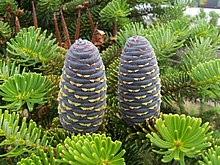
Back Abies AN شوح Arabic شوح ARZ Abies AST Ağ şam Azerbaijani آغ شام AZB Аҡ шыршы Bashkir Піхта Byelorussian Ельніца (дрэва) BE-X-OLD Ела Bulgarian
| Fir | |
|---|---|

| |
| Korean fir (Abies koreana) cones and foliage | |
| Scientific classification | |
| Kingdom: | Plantae |
| Clade: | Tracheophytes |
| Clade: | Gymnospermae |
| Division: | Pinophyta |
| Class: | Pinopsida |
| Order: | Pinales |
| Family: | Pinaceae |
| Subfamily: | Abietoideae |
| Genus: | Abies Mill. |
| Type species | |
| Abies alba | |
| Species | |
|
See text | |
| Synonyms | |
| |
Firs are evergreen coniferous trees belonging to the genus Abies (Latin: [ˈabieːs]) in the family Pinaceae. There are approximately 48–65[3][4] extant species, found on mountains throughout much of North and Central America, Eurasia, and North Africa. The genus is most closely related to Keteleeria, a small genus confined to eastern Asia.[5]
The genus name is derived from the Latin "to rise" in reference to the height of its species.[6] The common English name originates with the Old Norse fyri or the Old Danish fyr.[7]
They are large trees, reaching heights of 10–80 metres (33–262 feet) tall with trunk diameters of 0.5–4 m (1 ft 8 in – 13 ft 1 in) when mature. Firs can be distinguished from other members of the pine family by the way in which their needle-like leaves are attached singly to the branches with a base resembling a suction cup, and by their cones, which, like those of cedars, stand upright on the branches like candles and disintegrate at maturity.
Identification of the different species is based on the size and arrangement of the leaves, the size and shape of the cones, and whether the bract scales of the cones are long and exserted, or short and hidden inside the cone.
- ^ Cite error: The named reference
Schorn01was invoked but never defined (see the help page). - ^ "Drumheller region (Cretaceous to of Canada)". PBDB.org.
- ^ Torres, Leon Nahuel; Shi, Xiao; Na, Yuling; Wang, Bing; Tian, Chi; Chen, Jun (2024-03-01). "First study on fossil wood from the Middle Pleistocene of the Songliao Plain, Northeast China". Review of Palaeobotany and Palynology. 322: 105063. Bibcode:2024RPaPa.32205063T. doi:10.1016/j.revpalbo.2024.105063. ISSN 0034-6667.
- ^ Debreczy Zsolt Rácz István and Kathy Musial. 2011. Conifers Around the World : Conifers of the Temperate Zones and Adjacent Regions. Budapest: DendroPress.
- ^ Leslie, Andrew B.; et al. (2018). "ajb21143-sup-0004-AppendixS4" (PDF). American Journal of Botany. 105 (9): 1531–1544. doi:10.1002/ajb2.1143. PMID 30157290.
- ^ Coombes, Allen J. (2012). The A to Z of plant names : a quick reference guide to 4000 garden plants (1st ed.). Portland, Or.: Timber Press. pp. 17, 23. ISBN 978-1-60469-196-2. OCLC 741564356.
- ^ "fir | Origin and meaning of fir by Online Etymology Dictionary". www.etymonline.com. Archived from the original on 2021-08-08. Retrieved 2020-10-01.